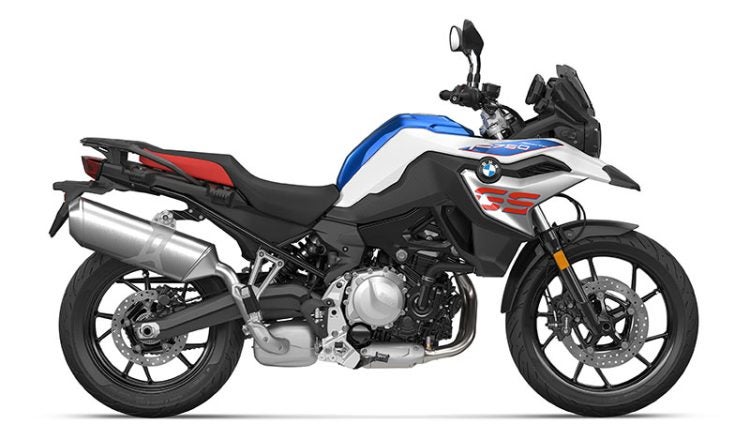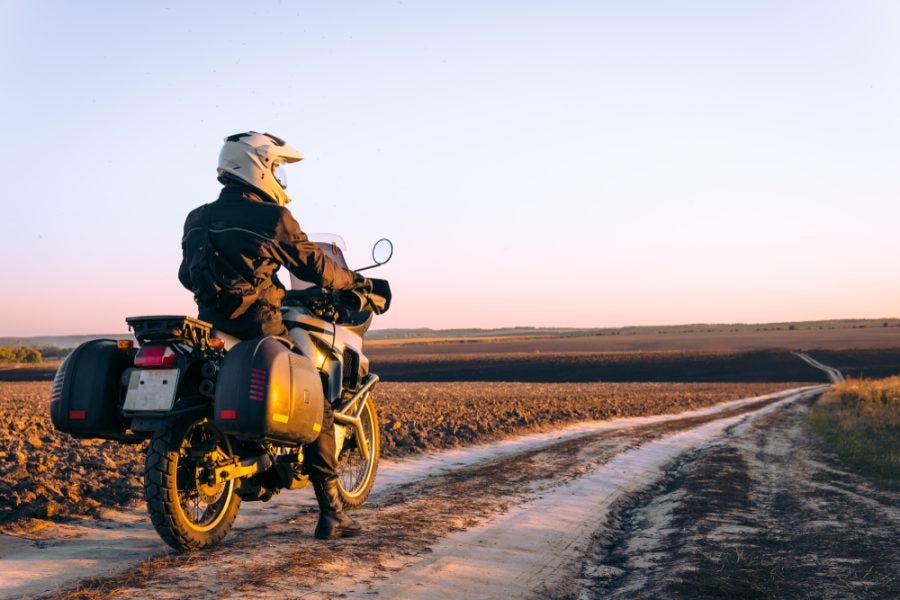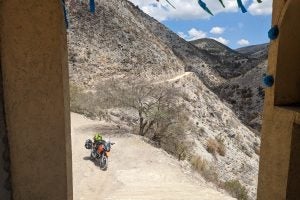To travel over rough terrain, most adventure bikes and dual sports have large-diameter wheels and long-travel suspension—and that means a seat height that’s taller than other motorcycles aimed at street-only riding.
As Neil pointed out in a recent column, that’s a problem for many prospective buyers. So what can you do, if you have a short inseam and you want to ride an adventure bike? Here are your options, listed from least expensive to most expensive:
Just learn to live with it
As a person with an awkwardly tall torso and weird, short legs, I will say that this is a subject I’ve dealt with for years, riding a wide variety of adventure bikes and jacked-up enduros that came through the doors at work. I remember the first time I rode a dual sport—I was used to cruisers and old UJM standards, and couldn’t believe how far my legs were stretching to the ground. I’ve heard other people express the same thoughts, when they jump aboard a dual sport for the first time. But the reality is that many short-statured riders are out there on tall bikes; they simply put the seat time in until they adapt to the machine’s size.
I will also say that this isn’t an option for everyone. And even if it was, there’s nothing wrong with wanting your motorcycle to fit you more comfortably.

Training is often very helpful for riders dealing with tall seat heights. You can learn a lot from watching YouTube, and even more if you go to in-person classes. Adventure riding training (D.A.R.T. training seen here at a DirtDaze event) will pay off throughout your entire riding career, but it’s not enough to have head knowledge. You must also practice what’s preached. Photo: Dirt Daze
Get trained!
This goes hand-in-hand with the first point. If you don’t have much money, training can be cheap as free (YouTube has a lot of advice from qualified instructors), or an expensive multi-day course. You can even do training tours with companies like Edelweiss, where you learn skills in exotic foreign locations. No matter how much you pay, the payoffs from practical instruction are tremendous and can last your whole riding career. A good riding instructor will help you figure out strategies for dealing with a tall motorcycle, along with a whole lot of other skills. See enduro instructor Megs Braap (aka Megan Griffiths) address this below:
Cut down your seat
Another option that’s low-cost, if you do the job yourself. Some riders simply cut out the foam of their motorcycle seat, and re-cover it—a classic trick for KLR owners in particular. For some riders, the end result is sufficiently comfortable. For others, the solution is a new aftermarket seat, cut lower but also designed with rider comfort in mind. Sometimes these are offered as DIY kits, which are also very cost-effective. Most motorcycle manufacturers also offer their own low accessory seat—these are available for most European adventure bikes, and some dual sport models. This solution is particularly effective when combined with a lowering kit—see below.
Install a lowering kit
Basic lowering kits aren’t very expensive. Usually, they consist of replacement parts for your bike’s rear shock linkage, priced in the $150-$200 range. To install, you replace the dogbones in your rear shock linkage and also adjust the front fork height to keep handling somewhat neutral. With these modifications, you get a seat height dropped an inch or two.
Many, many riders find lowering links are the answer they’re looking for—and many other riders find the altered suspension geometry just doesn’t work for them, which is why you can frequently find these lowering kits for sale second-hand, at significant savings. There’s certainly a trade-off here; your motorcycle suspension is designed to work a certain way, and many suspension lowering kits alter those characteristics.

A set of lowering links for the Yamaha Tenere 700, available as a factory accessory, meant to replace components in the stock suspension linkage. These alter the rear suspension angle and some riders find that undesirable. Others don’t care, and these are a very common modification because they’re affordable and easy to install. Photo: Yamaha
For motorcycles with no rear suspension linkage (KTM’s enduros with PDS being a prime example), the dogbone lowering kits will not work.
Also note that lowering kits are sometimes available from the motorcycle manufacturers themselves. The best example is the Suzuki DR650, which was specifically designed to be lowered with factory parts—if you flip the stock suspension linkage upside-down, and re-position a spacer inside the fork, the bike will sit lower. The only part you need to add is a lowered kickstand (available from Suzuki, or just cut the stock kickstand down).
If you want to change your bike’s seat height but lowering links don’t work for you, you can spend more money and get a replacement fork or fork springs and shock. This is a much more expensive solution, but if it’s been built to match your height and weight, it will generally work very well. Above, we showed you Megs Braap tackling obstacles on a too-tall dirt bike, but Megs also sometimes runs a lowered fork and shock that makes it easier for her to control the bike, as it’s matched to her height. Many of her videos show her running a Husqvarna adapted this way, and it certainly makes her life easier.

The BMW F750 GS, often the lowest seat height available on a multi-cylinder adventure bike. Basically the same machine as an F850 but with less horsepower and a lower saddle. BMW doesn’t promote these machines heavily, but they’d be well worth a look for riders with shorter inseam. Photo: BMW
Buy a “Low” bike
There are many small-cc and middleweight dual sports with relatively manageable seat height: Yamaha’s TW200 and XT250 are current-production examples, and historically, this was a big selling point for the XT225/Serow series as well. Kawasaki now offers the lower-from-the-factory KLR650S, as well as the KLX250S and KLX230S (see review here). Suzuki, as mentioned above, offers the factory lowering option for the DR650, and the DR200 is very manageable for most riders as well. Royal Enfield’s Himalayan and Scram models are also well-liked for their easily-manageable seat heights. Honda is reportedly about to offer a lowered CRF250L.
But what if you want a full-sized adventure bike with a twin-cylinder engine of at least 700cc? Along with the factory lowering kits for the R1250 and F850 GS models, BMW also sells the F750 GS, with lower ride height than the 850, although very similar. This can be combined with an Extra Low accessory saddle for a seat height of 30.7 inches.
Triumph also offers Low versions of several of some Scrambler and Tiger models from the factory. Like the F750 GS, you can’t expect these lower-riding Triumphs to have the same capabilities as their taller counterparts, but remember that it’s usually rider talent holding the bike back off-road, not the machine itself…

2023 Harley-Davidson Pan America 1250 Special. Photo: Harley-Davidson
Buy a bike with Adaptive Ride Height
This relatively new technology keeps the bike at a taller ride height while it’s moving, lowering the suspension as the machine slows/stops, so the rider can easily reach the ground with both feet. Harley-Davidson pioneered this tech with the 1250 Pan America Special adventure bike, and the Ducati Multistrada V4S also includes this feature now.
There are upsides and downsides to this technology. On the plus side, you get the best of both worlds: Improved handling dynamics while you’re riding, and no-stress stability at a stop. On the minus side, this is an expensive feature and it’s also one more thing to go wrong—and it might not work how you want it to, if you’re flogging the bike off-road and need to dab your foot in a pinch.
Despite these trade-offs, I expect this to become an option for most adventure bike flagships in coming years.







